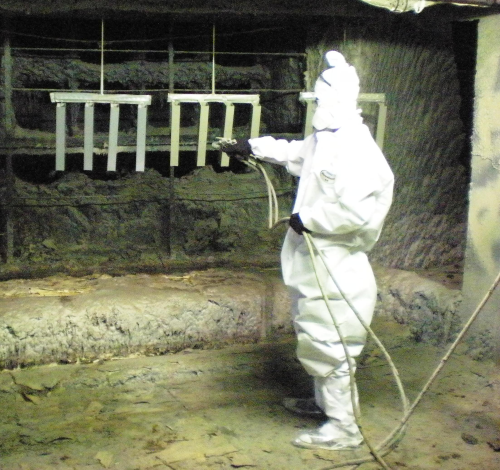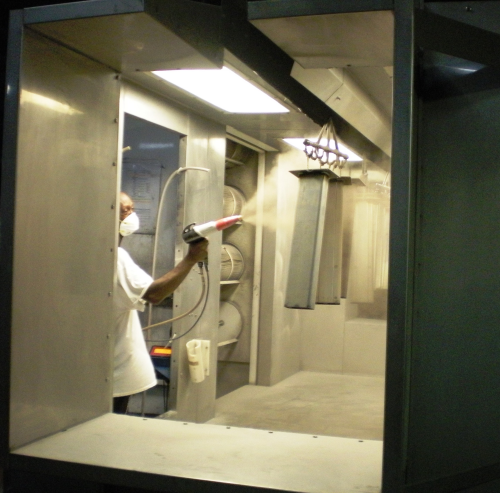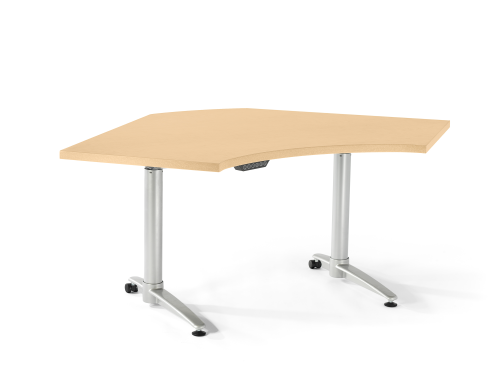


The new powder coatings line at Baker Manufacturing’s Pineville, Louisiana, facility was estimated to achieve its return-on-investment in five years. That didn’t happen.
Baker estimates that it only took about one year.
Return on invesetment (ROI), of course, was only one of Baker’s objectives. Often recognized for its forward thinking, the company’s primary goal when replacing an existing liquid spray coating line with the powder coating process was to achieve greater plant efficiency and manufacturing flexibility, plus enhance safety and boost its sustainability.
Never satisfied with the status quo
Set to celebrate its 60th anniversary in 2014, Baker Manufacturing is one of the largest U.S. manufacturers and suppliers of institutional furniture for the contract furniture market, which includes large-scale government and private sector contracts.
With its introduction in 1990 of height-adjustable tables and desks, Baker became a leading voice in the area of workplace ergonomics. Baker also claims to be the first manufacturer to achieve level® certification for its entire product line. The level recognition is a multi-attribute, sustainability standard and third-party certification program for the furniture industry administered by the Business & Institutional Furniture Manufacturers Association (BIFMA).
As an industry leader, the company is never satisfied with the status quo and decided, after more than 50 years of employing a liquid coating process to finish its metal components, to evaluate its coating techniques.
Coatings line review leads in a new direction
Traditionally, Baker employed a third-party vendor when powder coating certain furniture components such as table feet or round legs. Baker Manufacturing management occasionally thought about the possibility of adding a powder coating capability, and when it sought to upgrade the coatings line in 2008, Baker kept all options open.
Baker met with several coatings manufacturers, including Sherwin-Williams, a company that Baker Manufacturing contacted due to its reputation as a knowledgeable and reliable partner that provides complete solutions for customers. Liquid coatings, a viable solution for many applications, were a core component of the company’s business success and were regarded as the leading option for its future. However, to ensure that it maximized efficiencies, Baker Manufacturing chose to conduct a coatings line review.
Baker ultimately chose a comprehensive solution designed by Sherwin-Williams. Baker replaced the existing liquid spray capabilities with a powder coatings line that includes a three-stage process phosphate wash system, dryoff, cool down, a single powder coating spray booth, a cure section and 600 feet of track. The linchpin for Baker: The ability of the Sherwin-Williams Finishing System Sales & Service team to provide a complete coating system, not just the coatings.
“Baker elected to move to a powder coating process in an effort to modernize our facilities, improve the efficiency of plant operations, enhance quality control of our products, improve working conditions for our employees and become a better steward of the environment,” stated Brad Wytcherly, vice president of operations for Baker Manufacturing. “Working with Sherwin-Williams, we were able to recognize the cost savings and production improvements that made the move to powder coating a viable and smart option.”
The transition from liquid to powder
Installation and implementation of the powder coatings line needed to occur while Baker Manufacturing's coating operations remained fully operational in order to maintain production. To do so, Sherwin-Williams technical experts and design engineers worked closely with Baker on the installation of the new system to accommodate current and future coating needs, as well meet space and operations requirements.
“Sherwin-Williams worked around our schedule,” said David Selby, paint, metal and safety supervisor, Baker Manufacturing. “We kept using the liquid coating process for about six months after the powder coating line was installed because we wanted to utilize our existing liquid paint inventory – but it was hard for our team to go back to the liquid paint line after it began to use the more efficient powder coating process.”
Not only has the powder coating system saved floor space for Baker Manufacturing, but Selby reports the company is down to one oven, one paint booth, and much less track. "The installation of the enhanced phosphate wash system allows for a three-step process (wash, rinse, rinse) that has improved the quality of the paint application and created greater efficiency in our paint department,” Selby explained.
Another advantage – Baker was able to bring in-house the powder coatings work it formerly sent to a third party, eliminating that cost plus the freight.
Providing a safe, healthy and rewarding work experience
The Baker paint department was very receptive and excited about the powder coatings technology training. Sherwin-Williams provided three days of equipment and coating training for the department’s six employees who operate the line four days a week, 10 hours per day.
Baker believes that the powder coating process simplifies application and enables its team to work with a higher degree of success. More importantly, because powder coating is not considered a hazardous or flammable material, special suits and respirators are no longer required. The operators are only required to wear dust masks when applying powder.
“There was a time when I used to tell the guys, ‘Don’t Shave, Can’t Work’ because they had to be clean-shaven to wear a respirator," Selby stated. " like that the powder coating system requires minimum gear for my team and allows me to provide a cleaner, safer work environment at the plant."
Return on investment – and then some
Regular plant visits by Sherwin-Williams representatives continue to ensure that the process meets Baker’s needs. Baker Manufacturing's original five-year projected pay off realized a much quicker return due to the nearly 50-75% reduction in utility costs (gas, water, electric), plus the elimination of significant expenses related to hazardous waste disposal.
Baker Manufacturing also quickly realized that powder produced a greater yield – in some cases, depending on the part run, from 900 to more than 2,000 parts per day. That, combined with the improved application efficiency, more than made up for any cost difference between liquid and powder coatings.
When Baker applied for and achieved BIFMA’s level® certification in 2011, the new powder coatings system was a factor in several areas. The certification requires applicants to prove that the company addresses four impact areas:
- materials (including waste management)
- energy and atmosphere (including reducing energy impacts)
- human health and ecosystem (addressing the human and natural ecosystem health impacts of chemical constituents used in furniture products)
- social responsibility (including a commitment to employee health)
Baker Manufacturing is a just-in-time manufacturer and mandates 100 percent on-time delivery. The company credits the powder coating process as a key factor in its ability to meet this performance level for the past two years. Baker Manufacturing also believes that powder coating has supported its aggressive product development strategy by providing the ability to quickly and efficiently coat a variety shapes and colors, an option not available with its liquid coatings line.
“Baker prides itself on its on-time delivery promise and the implementation of the Sherwin Williams powder coat system has meaningfully impacted our ability to meet and exceed customer expectations,” said Justin Borland, production manager. “Sherwin Williams continues to be a valued and important partner.”





